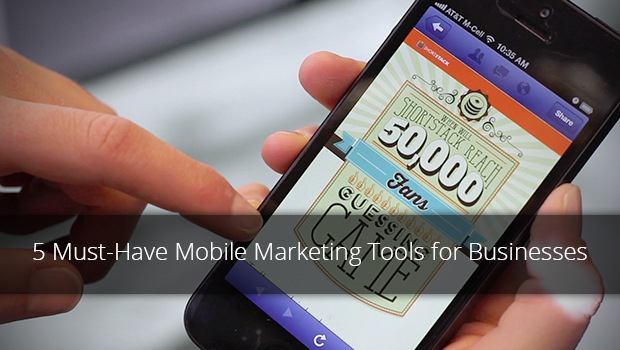
It seems like every week I read a new set of statistics about the importance of mobile in a company’s marketing strategy. Two of the most recent stand out. The first, from SteamFeed, included the fact that in the United States, 37 percent of internet usage occurs on mobile devices. The second and more interesting study — about U.S. smartphone users — was sponsored by Google. The Google researchers found that 67 percent of smartphone users in their survey said they are “more likely to buy from a mobile-friendly site.”
So what does this mean for businesses? It means you can no longer ignore mobile! It is here, it is powerful and it is a necessity. Most important: it’s not going away.
Here’s what you need now if you’re ready to go mobile:
#1: Responsive Design
Okay. You got me. Responsive design is not a tool. But until there is a tool that will magically take your existing website or blog and make it mobile-friendly, you have to make sure you have this base covered. Responsive design is a type of web architecture that makes the content — including text, images, forms, etc — flexible and dynamic. The site responds and conforms to the user’s device, whether it’s a desktop, smartphone or tablet. You’ve probably seen some excellent examples of responsive design and not even known it. That, by the way, is the goal.
Wells Fargo has done a nice job with responsive design. If you go to wellsfargo.com from a desktop, you will see many levels of navigation, some special offers, and large images. If you go to the same site from your smartphone, the content is totally different. The web designers (correctly) assume that if you are visiting the site from a smartphone, you most likely just want to find a nearby ATM or check your account balance. They leave out the fluff that you probably don’t need when you are out and about.
Responsive design isn’t just for websites though. Keep the principles of responsive design in mind whenever possible since you never know how users will access your content. Facebook Apps, email newsletters, downloadable coupons, videos, etc., should all look as good, and be as user friendly, on mobile as they are on desktop. The only way to know if your content is mobile friendly is to test, test, and test again.
#2: QR Codes
If you have both brick-and-mortar and online presences, you want to make sure that “on foot” customers have an opportunity to easily connect with the online side of your business.
Don’t you hate filling out little slips of paper and putting them into a box, or dropping a business card into a fish bowl? Your customers probably do, too. If you set up a QR code, your in-store customers can opt to receive coupons, special event announcements, newsletters, etc. as quickly and easily as your online customers can. Bonus: QR codes make it easier for you to manage the information you collect.
Remember when you were designing your website and you created those “Calls to Action” such as “Subscribe to my newsletter” and “Like us on Facebook”? QR codes are these same types of calls to action, but in the real-world.
We put a lot of emphasis on getting online visitors to opt in to a newsletter or Like us on Facebook so we can have a long-term communication channel with them. It’s smart to do the same thing with your offline customers, too. Perhaps if your customers received a coupon via email, they might come back into the store a little more often.
The cool thing about QR codes is they can be put virtually anywhere and lead people to anywhere online. A restaurant could put a QR code on a drink coaster or napkin and it could lead to a Facebook contest or a coupon for a special meal deal. The possibilities are endless… Just PLEASE don’t put a QR code in your email signature. Why would a customer want to scan a QR code when she’s obviously already on a computer or worse, reading the email on a smartphone?!
#3. Facebook Mobile Ads
Currently, Facebook has 680 million monthly active mobile users; Engineering Buddies recently reported that 47% of people who use social media access their favorite platforms from a phone or other mobile device. And the most popular free mobile app is Facebook.
Most businesses should already have a Facebook marketing strategy in place. But now that the majority of Facebook users visit the site from mobile devices, “mobile first” should be your motto. This means that all of your content, including advertising, should be easy to read and engage with on mobile.
Businesses can now target Facebook ads directly to mobile users. In January, Amy Porterfield wrote in Entrepreneur Magazine that “mobile advertising on Facebook is said to be producing better results than ads that appear in the right-hand column or in the news feeds for desktop-only users.” In order to reach mobile users you’ll have to use Facebook’s “Power Editor.” Amy Porterfield’s article also has some helpful tips for getting started.
The bottom line — businesses that aren’t taking mobile into consideration for their Facebook advertising budget could be missing a huge, and growing, audience.
#4. Yelp
There’s a long list of apps that people use when they’re on the go, but Yelp is one of the most important. Yelp receives an average of 86 million unique users a month, and I’m sure that a lot of them are not at home, looking for a bite to eat, some entertainment, or the best place to buy a certain product. According to Yelp, by the end of Q4 2012, Yelpers had written more than 36 million reviews. Yelp’s mobile app is also used on 9.2 million mobile devices per month. The point? Make sure your business information on Yelp is accurate, up-to-date and monitored.
Monitoring reviews, on Yelp and similar review sites, is also essential. It gives you valuable insight as to how your business is doing and what you could do to make it better.
#5: MailChimp
Email is a great way to announce company news, send resources, promote contests or giveaways, and give general updates to your customers. MailChimp is my favorite email tool for several reasons. There’s a free plan that’s ideal for small businesses — using it is a no-brainer! More important, MailChimp does a super job of providing best practices and mobile-friendly templates to get all its users started on the right foot.
More people are accessing email through their phones than their desktops or laptops, so having mobile functionality for email is a must. MailChimp also integrates with third-party platforms making it easy to collect email addresses on blogs and social media sites. (Disclaimer: I am not paid by MailChimp in any way, shape or form, I just think they are cool. And I like monkeys.)
#6: ShortStack
Earlier I mentioned the number of monthly active mobile users on Facebook (680 million for those of you who don’t want to scroll up). This number is important to businesses for several reasons, but I feel the most important is that it shows how many of your customers/fans are potentially visiting your Page from a mobile device. The only downside to this is that the Facebook smartphone app and mobile website do not display Facebook Page apps. Why? Who knows! But you can be sure that if you’re not creating your Facebook Page apps correctly, you’ll have some frustrated Facebook Fans commenting on your Timeline.
Your best option when building your custom Facebook apps is to choose a third-party application that has mobile capabilities baked in. At ShortStack we use “Smart URLs” to detect if a user is accessing an app from a mobile device or a desktop, then we serve them the appropriate content based on their device. (Disclaimer: I am paid by ShortStack — I own the place — and I love pancakes.)
If your business has neglected working mobile into your marketing strategy, you’re most likely missing out on an audience that is growing larger every day. There are tons of tools available to assist businesses in transitioning into the mobile-friendly world. The important thing is to make sure that your customers don’t have to think about the information you’re giving them. They should be able to focus on your brilliant campaign and not worry about any pain-points caused by poor architecture.



